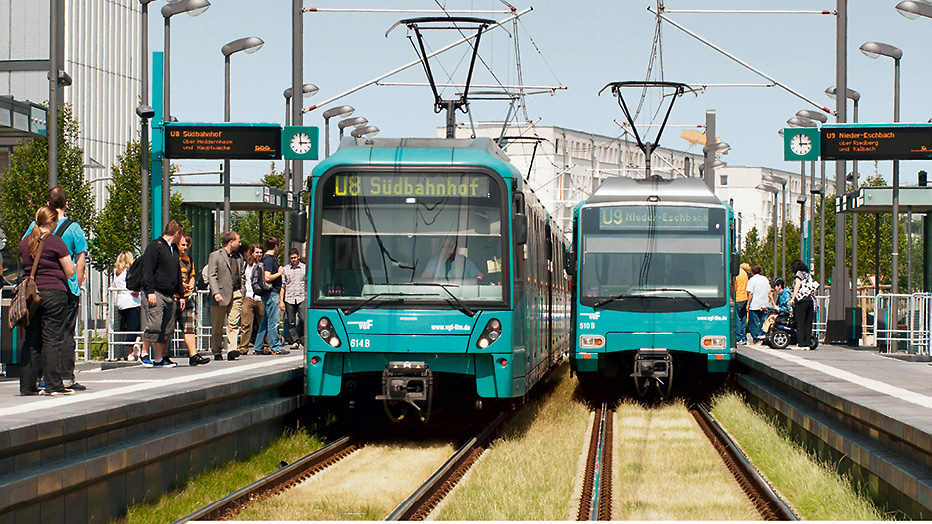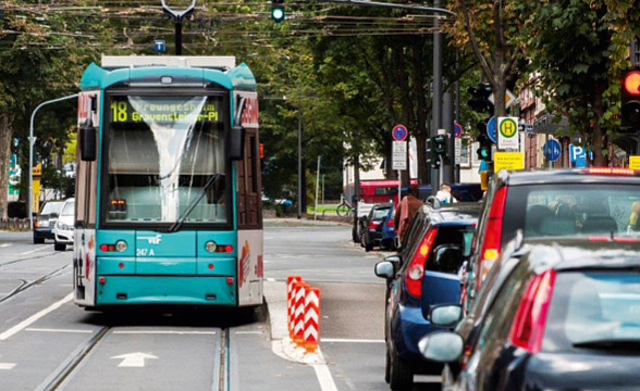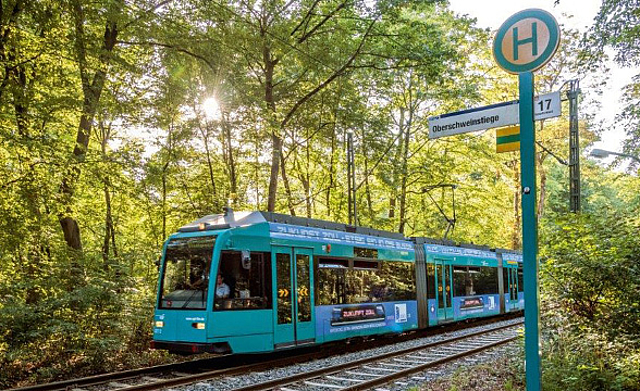Project Profile
Project Title: „Public transport as the backbone of mobility in the conurbation“
Subject Cluster: Mobility
Project Objectives: Promoting sustainable mobility, choosing public transport rather than the car, linking new and existing districts and suburbs to buses and urban railway.
Project Participants: Inter-departmental and interdisciplinary (Traffic, Urban and Environmental Planning, and others)
Contact: Kirsten Anlauf, traffiQ Lokale Nahverkehrgesellschaft Frankfurt am Main mbh
Good, rapid, reliable connections and an attractive timetable – expanding the bus and rail networks and giving new city districts access to local public transport encourage people to switch from the car to more sustainable urban mobility. Many new bus routes, tram- and city-rail lines have opened in Frankfurt in recent years.
Frankfurt is growing. Many new residential areas have been built in recent years and, as the population increases, the demand will continue to grow for housing, green spaces, social infrastructure and more efficient use of the existing traffic infrastructure and its sustainable expansion. The volume of traffic will also increase. Good connections from the new districts to the public transport network are vital if the way to work, to school, to the shops, to leisure activities is to be no longer made by car. Moving is a good opportunity for residents to structure their entrenched mobility patterns more sustainably – particularly if the options are appealing.
Riedberg: two lines to a new suburb
On Riedberg in the Northwest of Frankfurt a completely new city district with schools, day-care centres, parks and playgrounds, shops and gastronomy is developing. When all the construction projects are finished, 15,000 people will be at home there. A new urban railway route with two lines links the suburb to the existing local public transport network. The Underground line U8 (Südbahnhof–Riedberg) and U9 (Ginnheim–Nieder-Eschbach) have been running on the new four-kilometre line between Niederursel and Kalbach since the end of 2010.
Tramline 18: from traffic artery to city street
At the end of 2011, the 18 tramline to the new housing development on Frankfurter Bogen in the North of the city was put into operation. This meant completely remodelling Friedberger Landstraße, one of the city’s main traffic arteries. The number of car lanes on Friedberger Landstraße was reduced, cycle paths were built and the tree-lined avenue extended. Almost 100 new trees now enhance the street’s function as a cold air corridor.
The new tramline connects Frankfurter Bogen, quickly and directly, with the city centre in just under 20 minutes and offers an attractive alternative to the car.
Tramline 17: a new one-kilometre route creates a direct connection to the neighbouring city
At the end of 2014, a gap in Stresemannallee was closed: Completing the one-kilometre tram line resulted in the “new“ ten-kilometre Line 17 which created a rapid, direct connection from the neighbouring city of Neu-Isenburg in the South to Frankfurt Central Station, Messe and Festhalle and also to the new residential areas, City-West and Rebstock, with their innumerable workplaces.
The project also included extending the adventure playground there and re-designing Stresemannallee which greatly improved both the amenity values in the district as well as road safety with new, safe cycle guidance markings at the Kennedyallee/Stresemannallee intersection, one of the city’s busiest traffic junctions.

14 minutes-travelling time with the new Line 17 from Neu-Isenburg to the Central Station. The 18 tram travels from the Gravensteiner Platz terminus to Konstablerwache in 19 minutes. The U8 takes only 26 minutes from Riedberg to Südbahnhof.
Future projects: tightening the network, relieving existing routes
The U5 will be extended by 2021 past the current terminus, “Central Station“, into the new Europaviertel linking it directly and efficiently to Frankfurt’s public transport system.
The construction of the tram line, which closed a gap in Stresemannallee, is also the first part of the planned ring tram line which will circle the densely-built urban districts and will attract about 9,000 passenger journeys every day.
In the city-rail network, a second North-South connection between Ginnheim and Bockenheimer Warte will relieve the route via Eschersheimer Landstraße. A potential study showed that this connection could mean more than 12,000 new journeys every day – trips currently being made by car. It would also open planning options along the new routes for urban development in the growing city.

The growing city
More efficient use and expansion of the public transport network in order to handle the increased traffic volume of the growing population sustainably.

Mobility patterns
Linking all new urban districts and residential areas to the public transport network; changing home is a good opportunity to structure personal mobility more sustainably, particularly if the options are attractive.

Denser network
Relieving major routes; rapid and partly direct connections by closing gaps in the network and new direct lines result in increased numbers of passengers, creating areas for new residential housing.
Frankfurt public transport company (traffiQ Lokale Nahverkehrsgesellschaft Frankfurt am Main mbH)
Kirsten Anlauf
Tel +49 (0)69 212-25259
k.anlauf(at)traffiQ.de



